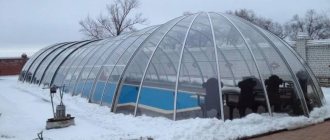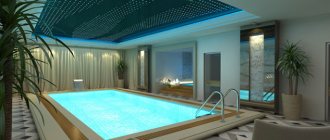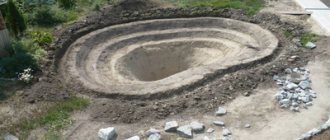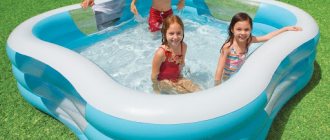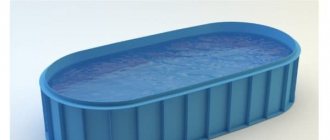If in winter the temperature in your region drops below zero, the pool must be preserved
Swimming pools in relatively warm areas, in covered and heated pavilions, where they are used for swimming year-round, do not require special winter conservation. The rest of the pools are definitely preparing for winter.
Before conservation for the winter, all pools are emptied of water, washed, disinfected, filtration systems are washed, pumps and filters are dismantled. After these basic steps, there are some differences in the preparation of different types of pools.
- If the pool is prefabricated or inflatable, it is dried, disassembled and stored according to the instructions.
- If the pool is shallow, the soil in your area does not freeze in winter, the pool bowl is made of a film lining the sides of the bowl pit (shallow “pool-pond”), or light, from loose acrylic, or if the pool is built as part of a building (for example, on roof or a common foundation with the building), then after disinfection it can overwinter dry - the main thing is to cover it with film or light shields from precipitation and debris.
- If the pool is built outdoors so that its bottom is at ground level and its walls are above ground level, it should winter dry.
- If the pool is built outdoors, its walls are in direct contact with the ground, and the ground freezes - it must be filled with water over the winter. Moreover, the water level will be different in different cases. Ideally, the water height should be 5-10 cm below the ground level and drain nozzles.
- All outdoor pools are covered with awnings, blankets, and shields for the winter.
Winter preservation rules
If you have an all-season model in mind, then in order to avoid damage to the equipment and perform quality conservation, you must adhere to the following recommendations:
the tank must be preserved until the air temperature drops to 0°;- The pool bowl must be filled with water;
- Water should be added only after cleaning work has been carried out inside the pool and the equipment has been removed;
- When cleaning tank walls with special compounds, precautions should be taken because they are toxic;
- Removal of equipment inside the tank must be done carefully so that the hydraulic system is not damaged.
It is prohibited to add preservatives to water intended for swimming!
Seasonal models begin to be dismantled, after draining the water. The procedure is not particularly difficult, but compliance with some rules is mandatory:
- Simultaneously with draining the water, it is necessary to thoroughly clean the entire internal surface. First of all, completely remove limescale from the metal parts of the structure.
- To prevent small structural parts from getting lost, it is better to pack each of them separately.
- You need to dry the pool as best as possible.
- If heating is not provided in the room where the dismantled structure will be stored, dense packing of the material is required, because Due to its fragility, it can be damaged by exposure to low temperatures.
Nothing is simpler
So, now you have clear instructions for action:
- drain the water
- rinse the pool,
- pour water with chemicals, filter,
- wash and dry equipment,
- put plugs,
- place half-empty plastic bottles,
- cover with an awning.
After this, you can safely leave your pool to spend the winter at the dacha. And no frost will be scary for him. And with the arrival of the swimming season, it will again delight its guests with warm clear water for many years to come.
IMPORTANT! The ice in the pond should melt naturally. There is no need to split it, as sharp chips can damage the thicket of the structure.
Storage rules
Proper storage of the pool in winter directly determines the condition in which it will meet the new season.
How to wash and clean before wintering?
The classic way to clean a seasonal pool from dirt and plaque:
- Cleaning begins by opening the drain hole. If detergents were added to the water before, it must be drained strictly into the sewer system, preventing it from getting into the soil.
- The remaining water is scooped out with a regular ladle.
- Using a brush with synthetic bristles, carefully clean the plastic sheet of the pool from silt. It is not recommended to use a wire brush - it can easily damage the material.
Experienced seasonal pool users have come up with many interesting cleaning methods.
Here are some of these recommendations:
- Having drained the water to a level just below the knees, you need to clean the walls with a brush, wetting it in water. The pump continues to operate and pump out water. Then, using a standard vacuum cleaner attached to the pump, vacuum the bottom of the pool. Finally, wipe the bottom with a cloth and leave to dry for a day.
- You can also drain the water by gravity by attaching a hose to the drain hole. Of course, this process will take several hours.
- When installing a pool under the bowl, it is recommended to make a recess: then, after draining, the remaining water will collect there, and it will be easy to scoop it out without driving water all over the bottom of the pool.
How to unmount?
The method of folding the plastic bowl depends on the shape of the tank:
If the pallet is rectangular, it should be folded like a sheet, avoiding folds and creases.- Folding a round bowl begins by laying the walls inward, after which the bottom is folded in half twice. The result is a triangle, which is further reduced to a convenient size.
- If there is a cable inside, then it is removed from the loops.
Before folding the fabric, check drying of all folds and hard-to-reach places so that not a single drop of water remains. Only a perfectly dried pool is guaranteed to last until the next season. Small bowls can be dried by hanging them on lines.
The frame is quite easy to disassemble:
- The pins are unscrewed, the side and bottom hinges are disconnected, and the beams are removed.
- The vertical supports are dismantled, the nozzles, hinges and hinges of the awning are removed.
- During the dismantling process, it is important not to forget to rinse the drain hoses: it is good to do this with a mixture of citric acid and Feri-type dishwashing detergent.
- All components are marked and placed in packaging.
How and where to save structural parts?
The frame parts (unlike the bowl) can withstand storage at low temperatures. Therefore, once packaged and labeled, they can easily be left in a garage or country house for the winter. As for the bowl, it needs to be stored only in a heated room.
The pool liner is perfectly stored in the vegetable store. Holes that form in places where there are creases can be repaired with self-adhesive cheap patches: such repairs can withstand one season just fine.
Is it possible to store a swimming pool at minus temperatures?
You can leave the assembled pool outdoors for the winter only if it is made of metal. Off-season models tolerate frost well and do not suffer from temperature changes.
As for the proper storage of plastic-type pools, they are dismantled when cold weather sets in in the fall. If such a tank is left assembled on the site, it may suffer. The danger to the structure is:
- temperature changes, under the influence of frost the walls become deformed and crack;
- rodents - in winter and spring, a tank left unattended for storage can be chewed by garden pests;
- vandals; in the absence of the owners, hooligans can get into the site and damage the property;
- natural precipitation, melt or rain water does not always have a good chemical composition and can damage the walls of an abandoned tank.
Attention! Leaving a frame pool outdoors for storage throughout the winter is only possible in southern regions where the temperature does not drop below zero.
The frame pool is cleaned before the cold weather when the temperature is set at about 10 ° C
Outdoor storage of a frost-resistant model
Out-of-season models can be left outside in winter. The main condition for such storage is the mandatory presence of water in the tank.
Otherwise, the frame is in danger of deformation, and the film will be covered with numerous cracks. There is also a danger of the empty structure being damaged by rodents and blown away by the wind.
How to wash and clean?
The main cleaning steps are as follows:
- The water from the bowl should be partially drained, bringing it to a level just below the nozzles.
- After adding special chemicals to the water, you should leave it for a couple of hours to filter - this will prevent “blooming”.
- Wash the walls and bottom of the pool from silt deposits using a synthetic brush.
Practical advice from experienced owners:
- Contrary to the instructions, it is better not to remove lime deposits from the walls of the pool: after exposure to low temperatures, it can be easily removed with a regular brush in the spring.
- Completely drain the pool and dry it. It is very convenient to drain water if you construct a device from a hose and a plastic pipe in such a way that they communicate with each other. The same device can be used as a “vacuum cleaner”: having drowned it in water, you need to close the end of the hose with your finger, like a cork, and take it outside below the water level. When the finger is removed, the water will flow without problems.
- The dry pool is cleaned with a brush, after which water is pumped in with a pump with a filter.
- By working with a brush with an elongated handle like an oar, you can create a kind of whirlpool at the bottom of the pool. All the dirt will swirl into it and in a few minutes will gather in the central part of the pool in the form of a neat pile. This pile can easily be sucked up by the self-designed “vacuum cleaner” mentioned above.
What equipment needs to be removed?
Before preservation it is necessary to remove the following components:
- filters;
- pipes:
- skimmer;
- lamps, safety glass.
Water level
When filling the pool with water, special preservatives should be added according to the instructions.
The optimal water level is 10-12 cm below the side nozzles.
What chemicals should I add?
It is recommended to use additives such as “Puripul” (company-) as preservatives There are a number of analogues on sale. These substances prevent bacteria from multiplying. The solution is made in a ratio of 1X5.
Installation of expansion joints
To avoid damage to the pool due to the expanding volumes of frozen water, compensators must be lowered into it.
To do this, plastic bottles, old tires or pieces of polystyrene need to be weighed down with a load and, having tied them to each other for uniform distribution, are immersed in the pool.
Compensators will take on the pressure of expanding ice and prevent the sheet from tearing.
Other conservation measures
- Be sure to insulate the wiring and install plugs.
- The built-in autochlorinator must be removed from the dispenser.
Additionally, the structure can be protected with an awning. Do not forget that the awning itself must be made of material that is not afraid of frost.
It is strictly not recommended to cover a pond with homemade wooden or metal shelters : they can damage the walls of the structure with their pressure.
Choosing a coating to protect the water surface
Protecting the water surface with a special coating is considered the last step in the winter conservation of outdoor pools. This stage does not bring any trouble to the owners of those structures that already use coatings to protect the pool water from contamination and cooling in the summer. True, only those covering materials that can withstand temperature changes, as well as the severity of the snow mass, are suitable for year-round use.
Tent coverings are made from tarpaulin, polyvinyl chloride film and other materials that can protect the water column from precipitation and other contaminants.
Bubble blankets are inexpensive types of heat-insulating coatings that can accumulate solar energy. Blankets are suitable for protecting a pond in winter
Automatic roller blinds for swimming pools allow you not only to protect the water surface from pollution, but to extend the swimming season, keeping the water temperature in the pool at a comfortable level
Plastic pavilions are considered an expensive type of year-round protection for outdoor pools. These structures are made from rounded aluminum profiles and polycarbonate sheets that can retain heat inside the structure
Operation of an outdoor (stationary) swimming pool in winter is possible using modern systems for electric heating of water in an artificial reservoir
It is not recommended to cover outdoor pools with homemade wooden shields and metal structures resting on the sides of the structure. There is a high probability of damage to the walls of the bowl and the body of the artificial reservoir.
How to re-open before the start of the swimming season?
With the onset of warm spring days, I want to put my home pond into operation as quickly as possible. This must be done correctly.
Seasonal model
Before installing a seasonal pool, first tidy up the area where it will be located:
- The area is cleared of garbage.
- The area is leveled and a bedding is laid on it to protect the bottom of the pool.
- The stakes are driven in onto which the frame is stretched.
- All parts should first be washed and the pool rinsed.
Frost-resistant pond
Under no circumstances should you break blocks of ice with a crowbar ! You must wait until the ice melts naturally.
You need to start cleaning a stationary pool after winter as soon as the night air temperature reaches 10 degrees. If you wait until it gets hot, the water will certainly “bloom.”
If the pool was covered from above for the winter, then there will be much less debris in it than in an open one.
But in any case, careful cleaning and washing with disinfectants will be required:
Having descended into the bowl, you should thoroughly rinse every corner of the pool. This is done using brushes and/or vacuum cleaners. Special chemicals for swimming pools should be added to the water, which does not create foam (it will be very difficult to get rid of foam after draining the water).- Remove the winter plugs from the injectors and skimmer.
- After de-energizing the system, install spotlights.
- Install stairs and handrails.
- Connect pumps and filters.
- Install disinfection equipment.
- Fill the pool with water, exceeding the level of the middle of the skimmer by 3-5 cm.
- Adjust the acidity of the water.
- Shock the water with a chlorine-containing substance.
- Without turning off the filtration, leave the pool for 1 day.
- Dirt that has collected at the bottom in the form of sediment must be carefully collected with a vacuum cleaner.
- The filter needs to be washed a couple of times.
- Turn on the ultraviolet and filtration system.
After all these procedures are completed, the pool will be fully prepared for use.
When can reactivation begin?
If you carry out all the procedures for preserving a stationary pool correctly, you can ensure a successful winter for this structure. With the arrival of warm days, the ice in the pool is allowed to melt naturally. It is strictly forbidden to crush ice, as this is likely to damage the bowl of the structure. After the pool is re-opened and the water is purified, the reservoir begins to operate in accordance with its purpose.
- Author: marika
Rate this article:
- 5
- 4
- 3
- 2
- 1
(2 votes, average: 5 out of 5)
Share with your friends!
Preparing for winter
Pool conservation consists of several mandatory steps that are strongly recommended to be followed:
- Emptying the cup from the water with which it was filled in the summer. A pool whose walls are not immersed in the ground is left dry for the winter. The reservoir, the walls of which are immersed in the ground, is again filled with water during wintering. In this case, its level should be 5 or 10 centimeters below the level of the soil and drain nozzles.
- Thorough cleaning of all elements, parts and surfaces. Cleaning products should be selected according to the type of surface to be cleaned.
- Dismantling of lamps built into the walls of the pool.
- Washing pump filters.
- Disinfection.
- Pouring salt-protective agents into the water.
- Installation of polystyrene foam, plastic containers, car tires or special floats as load balancers.
- Draining excess water resulting from immersion of expansion joints in the pool.
- Removing the hydraulic system. All technological equipment is disconnected, and the part of the system located on the street side is freed from water. The ends of the pipes are closed with plugs. The holes created as a result of dismantling are also closed with plugs. All removed elements and parts are stored in a warm, dry place.
- Covering the pool with a special coating. You can use a wooden or metal shield, but only if a special support structure is erected around the pool. Such shields cannot be supported on the sides.
Features of conservation
The main stages of preparation for wintering:
- drain
- disinfection
- washing pumps and filters
- equipment dismantling
For example:
- Inflatable and prefabricated structures are dried, disassembled and stored in accordance with the requirements set out in their operating instructions.
- Shallow pools can be left dry for the winter in two cases. If they are installed in an area with non-frozen soil or installed on a common foundation with an adjacent building.
- Without exception, all pools that are located in the open air must be covered during the winter.
Photos of pools built by our contractors:
- 4 months ago
#swimming pool#swimming poolin the house#swimming pool#swimming pools#swimming pool at the dacha#swimming pool for children#swimming pool at home#swimming poolmoscow#construction#construction#pump#tilesforpool#swimming pools#counterflow#frame pools#heated pool#pool construction
- 4 months ago
#swimming pool#swimming poolin the house#swimming pool#swimming pools#swimming pool at the dacha#swimming pool for children#swimming pool at home#swimming poolmoscow#construction#construction#pump#tilesforpool#swimming pools#counterflow#frame pools#heated pool#pool construction
- 4 months ago
#swimming pool#swimming poolin the house#swimming pool#swimming pools#swimming pool at the dacha#swimming pool for children#swimming pool at home#swimming poolmoscow#construction#construction#pump#tilesforpool#swimming pools#counterflow#frame pools#heated pool#pool construction
- 4 months ago
#swimming pool#swimming poolin the house#swimming pool#swimming pools#swimming pool at the dacha#swimming pool for children#swimming pool at home#swimming poolmoscow#construction#construction#pump#tilesforpool#swimming pools#counterflow#frame pools#heated pool#pool construction
- 4 months ago
#swimming pool#swimming poolin the house#swimming pool#swimming pools#swimming pool at the dacha#swimming pool for children#swimming pool at home#swimming poolmoscow#construction#construction#pump#tilesforpool#swimming pools#counterflow#frame pools#heated pool#pool construction
During the winter period, snow from the surface must be regularly removed. It is not recommended to walk on frozen water. It is also not worth opening the cover before the start of the swimming season. It is best to re-open the bowl just before the start of the swimming season. The ice in it must melt naturally and in no case should this process be accelerated. Do not prick it, cover it with salt, or use chemicals or heating devices. Such measures can lead to damage to the walls of the reservoir. Only if all maintenance and conservation requirements are met will the pool withstand different weather conditions without problems and last for a very long time.
- Enter the parameters of your pool or simply leave a request
- We will receive an estimate for your project from each of our contractors
- We will choose the best offer and contact you
- You will get a pool at the best price
Your promo code: “Pool for you”! Tell it to our employee and the surveyor’s visit will be free for you.
Is it worth cleaning a frame pool for the winter? How to store a frame pool in winter
Pleasant to use and easy to store
How to store a frame pool in winter? Read about storage conditions for frame pools in our article.
If you still decide not to, but to remove it, then of course this is also the right decision. Moreover, if the pool bowl at the dacha is not deepened, but simply stands on a prepared cemented area, to which nothing will happen in the winter.
Storing a frame pool in winter is possible even in assembled form. It is more convenient to prepare the pool for dismantling before the onset of cold weather. If you use a special pump with table salt, which purifies water by passing it through itself, then such a liquid can be drained into the garden without chemicals. But the use of pool chemicals is almost a prerequisite. Since warm water will bloom within a week. Therefore, it must be drained into the sewer. Of course, it is more convenient to prepare a drainage hole for the pool and not worry about where to drain the water every year.
Storage conditions for frame pools
There is nothing complicated, you just need to follow certain steps according to the instructions:
- drain the water
- thoroughly wash the walls from plaque and mold. This can be done with a regular car brush. It is quite tough, but will not damage PVC. And the detergent should not be aggressive,
- remove all existing equipment, rinse well, dry and carefully place in a dry box.
ADVICE! It is advisable to dry the structural elements in the open air, ideally under the sun's rays, and the pool should remain in the open air for at least 1 hour.
If your bowl consists only of metal supports and an awning, then winter storage of the frame pool must be done in a dry, warm room. Disassemble the structure element by element and mark it so that it is easy to assemble the frame next year. Special care is taken with film. First, rinse it thoroughly and dry all folds on the outside and inside.
If you hurry, you'll make people laugh
After the material has completely dried, sprinkle it with talcum powder. This is necessary so that storing the frame pool rolled up does not lead to gluing of the material from which the bowl is made. A rectangular pool is much easier to roll up than a round one. Fold it like a regular sheet, smoothing out all the wrinkles. It's more difficult with a round pool. Fold into the inside of the bowl wall, then the circle in half twice. You will get a triangle. You cannot leave a swimming pool in an unheated dacha.
It is important to store the film in a dry, warm place, as frost will make it brittle and next year it will crack and will have to be patched. Nothing should be placed on top of the rolled PVC film to avoid creases and keep animals out
ADVICE! To make the pool convenient to fold, it needs to be shaped like a square. This can be done as follows:
- start rolling the product on one side, while wrapping up about 1/6 of the material;
- repeat the manipulation on the other side, folding the material several times so that the final folding structure resembles a book.
As easy as pie
How to store the bowl of a frame pool if it consists of a frame and plastic or metal panels? Everything is much simpler here. Preparing a pool for cleaning is the same as for everyone else. And the assembly of the structure is complemented by plastic or metal shields. All plates are washed, wiped, folded and put away. Temperature is not important for them. But the requirements for the material for the bowl are the same.
ADVICE! For proper storage, it is important to choose a suitable room. The room should not be too hot (ideally, if the room is cool, no higher than 18 C), and it should not be humid and have good ventilation.
After reading our article, now you have an idea of how to store a frame pool. All that remains is to make this a reality. We hope that you will not have any difficulties or special work. The main thing in this matter is not to rush, so that next year you will again enjoy the cool water in your pool.
Why dismantle the pool?
Some owners of suburban areas prefer not to deal with the labor-intensive procedure of dismantling frame pools after the end of the swimming season. People rely on the fact that by covering the container with film, they will protect it from the influence of all external factors. In some cases, the luck factor kicks in and the tank survives the winter without damage.
But it should be borne in mind that during the off-season the following troubles can occur with the pool:
- Even the most thorough sealing of the container will not protect it from moisture. The result will be filling the reservoir bowl with rain and melt water. Its chemical composition can be quite aggressive and destructive to plastic.
- Pools can become habitats for wild and domestic animals. They can harbor entire colonies of rodents and small predators. It is far from certain that they will not test the strength of the plastic and frame with their teeth and claws.
- Impact of vandals. As a rule, dachas and country houses are left unattended in winter. Hooligans or robbers can destroy the tank simply from idleness or due to a bad mood.
- Fluctuations in the freezing and thawing of water in the bowl negatively affect the plastic, which at subzero temperatures hardens and becomes brittle.
The owner of the dacha who says: “Every year I dismantle the frame pool and store it indoors” is acting very far-sightedly. It is better to spend time on disassembling and assembling the product than on its disposal, delivery and installation of a new tank, which has a considerable cost.
Is it possible to store a swimming pool at minus temperatures?
Some owners of artificial frame-type ponds prefer not to carry out the labor-intensive work of dismantling them when the swimming season is over. They believe that using film to cover them will be enough to protect them from the harmful effects of external factors. But this technique does not always work, and the tank loses its integrity.
Proper storage of your pool can extend its lifespan.
Among the common unpleasant moments that arise during the off-season are:
- Filling the tank with rain or melt water. Even with high-quality sealing, moisture gets into the container; if its chemical composition turns out to be overly aggressive, the plastic will not withstand it and the process of destruction will begin.
- Settlement of wild or domestic animals. Rodents and small predators often live in such structures. As a result of their vital activity, damage occurs not only to the plastic, but also to the frame.
- Impact of bullies. In most cases, dachas are unattended in winter, and vandals damage property.
- The fragility of plastic under sudden temperature changes. If the water in the tank first freezes and then thaws, the pool becomes vulnerable to damage under such conditions. The material hardens at sub-zero temperatures and becomes very brittle.
It is possible to leave a frame pool outside for the winter if the model is all-season. It is designed taking into account compliance with all rules. Most prefabricated pools allow this storage method to be used during the cold season. For structures that do not have a sufficient degree of frost resistance, this technique is not relevant; a complete disassembly of the pool will be required.
As for inflatable water tanks, you shouldn’t just leave them outside in winter. When exposed to low temperatures, the material loses its performance characteristics and is easily damaged, which requires either repairs or the purchase of a new pool for the next season. Only in regions with a warm climate, where air temperatures are not lower than 0°C, can you do without additional shelter.
Important! Before putting the pool away for storage, you need to familiarize yourself with information about the permissible temperature levels at which the product does not lose its performance characteristics. This information is indicated on the packaging.

